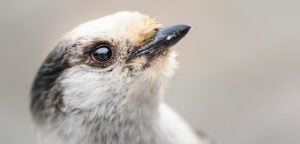
Wildlife
The naturalist and the wonderful, lovable, very bold jay
Canada jays thrive in the cold. The life’s work of one biologist gives us clues as to how they’ll fare in a hotter world.
- 3599 words
- 15 minutes
This article is over 5 years old and may contain outdated information.
Wildlife

I’m writing about an old relative, one that goes by many names. To the Cree, she is wisikejack. To the French, she is mésangeai du Canada. To the English, she is gray jay. To my people, the Anishinaabe, she is Gwiingwiishi.
Gwiingwiishi has lived with us since the beginning. She is a life giver, a trick player and one of the smartest beings in Creation. Everything she does challenges thought and perception, gifting teachings of responsibility, relationships and life.
Many say she is a food-stealer, but she is brave in her fearlessness, bright in her mistakes. She is kind to those who are kind back, harder on those who need a dose of humility. She is the best parts of all parts.
Unlike many birds, she stays among our lodges all year, watching, playing and calling for our attention constantly. She is fierce in her protection of her family and community, travelling only with her relatives and taking care of her young. She hides her food in tree caches, as she is constantly on the move, constantly going and returning, constantly visiting all. Gwiingwiishi is a great, wise teacher, and there is an old story that tells of her abilities to give gifts.
One day long ago, our great trickster-transformer Nanabozho changed himself into Gwiingwiishi and sat in a tree above two blind brothers as they began to share a meal. As the first man reached for a piece of meat, Gwiingwiishi flew down and stole it. Startled, the man asked his brother if he had taken his meat. The brother replied no, reaching for a piece himself. As he was about to place the food in his mouth, Gwiingwiishi flew down and stole it, too, then returned to the tree to watch. The brothers accused one another of stealing, arguing with fear that one was trying to hurt the other. Just before they came to blows, Gwiingwiishi let out a huge laugh. Suddenly, the two men realized that Nanabozho was playing a trick, teaching them to not let petty things come between them. Nanabozho transformed back into a human but left a spirit of play and gift giving within Gwiingwiishi, something she still shares today. Her lesson? That it is only in our bravery, resilience and commitments to one another that we can find growth.
Are you passionate about Canadian geography?
You can support Canadian Geographic in 3 ways:

Wildlife
Canada jays thrive in the cold. The life’s work of one biologist gives us clues as to how they’ll fare in a hotter world.

Wildlife
After two years, nearly 50,000 votes and thousands of public and expert comments, the Canadian Geographic National Bird Project concludes. Meet our newest national emblem.

Wildlife
An estimated annual $175-billion business, the illegal trade in wildlife is the world’s fourth-largest criminal enterprise. It stands to radically alter the animal kingdom.

Wildlife
This past summer an ambitious wildlife under/overpass system broke ground in B.C. on a deadly stretch of highway just west of the Alberta border. Here’s how it happened.